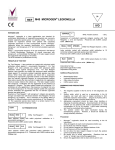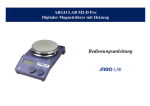Download en fr de
Transcript
en fr de INTENDED PURPOSE UTILISATION ANWENDUNGSBEREICH Helena Ristocetin Reagent is intended for use in the quantitative determination of an activity that reflects von Willebrand factor activity in 1 plasma . It is used to measure the ability of a patients plasma to agglutinate formalinfixed platelets in the presence of ristocetin. The rate of ristocetin-induced platelet agglutination is related to the concentration of von Willebrand factor. WARNINGS AND PRECAUTIONS The reagents contained in this kit are for in-vitro diagnostic use only - DO NOT INGEST. Wear gloves when handling all kit components. Refer to the product safety data sheets for risk and safety phrases and disposal information. Plasma products have been screened and found negative (unless otherwise stated on the kit box or vial) for the presence of Hepatitis B Antigen (HbsAg) HIV 1 and 2 antibody and HCV antibody; however they should be handled with the same precautions as a human plasma sample. COMPOSITION 1. 2. Ristocetin Reagent (5 × 1.5ml) Each vial contains 15mg of Ristocetin lyophilised with stabilisers. Preparation: Reconstitute each vial with 1.5ml of purified water. Swirl gently and allow to stand for 10 minutes. Mix gently before use. Do not shake. Other kit components Each kit contains Instructions For Use. STORAGE AND SHELF-LIFE 1. Ristocetin Reagent Unopened vials are stable until the given expiry date when stored under conditions indicated on the vial or kit label. Once reconstituted, the reagent is stable for 8 hours at 2...6°C or 30 days at -20°C. Le réactif Ristocétine Helena est utilisé dans la détermination quantitative 1 d’une activité qui reflète l’activité du facteur von Willebrand dans le plasma . Il sert à mesurer la capacité d’un plasma patient à agglutiner des plaquettes fixées au formol en présence de ristocétine. Le taux d’agglutination plaquettaire induit par la ristocétine est proportionnel à la concentration du facteur von Willebrand. PRÉCAUTIONS Les réactifs du kit sont à usage diagnostic in-vitro uniquement. NE PAS INGÉRER. Porter des gants pour la manipulation de tous les composants. Se reporter aux fiches de sécurité des composants du kit pour la manipulation et l’élimination. Un dépistage des produits à base de plasma a été réalisé et a donné un résultat négatif (sauf indication contraire sur la boîte du kit ou sur le flacon) pour les antigènes de l’hépatite B (AgHBs), les anticorps anti VIH 1 et 2 et les anticorps anti VHC; il est malgré tout nécessaire de les manipuler avec les mêmes précautions que pour les échantillons de plasma humain. COMPOSITION 1. 2. STOCKAGE ET CONSERVATION 1. ITEMS REQUIRED BUT NOT PROVIDED REF 5371 REF 5356 REF 5185 REF 5365 REF 5355 Lyophilised Platelets 5 x 5ml or Lyophilised Platelets 5 x 10ml SARP 10 x 1ml Tris Buffered Saline 1 x 125ml or Tris Buffered Saline 10 x 35ml Plastic or siliconised glass should be used throughout. Blood (9 parts) should be collected into 3.2% or 3.8% sodium citrate anticoagulant (1 part). Separate plasma after cetrifugation at 2000 - 3000 x g for 15 minutes. Plasma should be kept at 2…6°C. Testing should be completed within 2 hours of sample collection, or plasma can be stored frozen at -20°C for 2 weeks or -70°C for one month. Thaw quickly at 37°C prior to testing. Do not keep at 37°C for more than 5 minutes. STEP BY STEP PROCEDURE Prepare all reagents as instructed with each pack. aggregometer as indicated in the instruction manual. Set up platelet Standard Curve Preparation Prepare the following dilutions in Tris-buffered saline : Tube 1 2 3 Dilution 1:2 1:4 1:8 SARP ml 0.1 0.1 0.1 Buffer ml 0.1 0.3 0.7 Activity % 50 25 12.5 Mix without shaking. 2. 3. 4. a) b) c) d) e) Réactif Ristocétine Les flacons non ouverts sont stables jusqu’à la date de péremption indiquée s’ils sont conservés dans les conditions indiquées sur l’étiquette du kit ou du flacon. Une fois reconstitué, le réactif est stable 8 heures entre 2...6°C ou 30 jours à -20°C. MATÉRIELS NÉCESSAIRES NON FOURNIS SAMPLE COLLECTION AND PREPARATION 1. Réactif Ristocétine (5 × 1.5ml) Chaque flacon contient 15mg de ristocétine lyophilisée additionnée de stabilisants. Préparation: Reconstituer chaque flacon avec 1,5ml d’eau distillée. Remuer doucement et laisser reposer 10 minutes. Mélanger doucement avant utilisation. Ne pas agiter. Autres composants du kit Chaque kit contient une fiche technique. Patient Sample Preparation Prepare 1+1 and 1+3 dilutions of the patient plasma or control plasma in Tris-buffered saline. Mix without shaking. Aggregation Blank Preparation Pipette 0.25ml of platelet suspension and 0.25ml of Tris-buffered saline into an aggregometer cuvette with a stir-bar. This is used to set the 100% activity level. Testing Set the 100% activity in each channel using the Aggregation Blank sample. Pipette 400µl of platelet suspension into an aggregometer cuvette for each sample to be tested. Add a stir-bar to each cuvette. Place the cuvette into the aggregometer and add 50µl of Ristocetin to the cuvette. Incubate at 37°C for exactly 3 minutes. Add 50µl of standard, patient or control plasma dilution. Monitor platelet aggregation for 5 minutes. REF 5371 REF 5356 REF 5185 REF 5365 REF 5355 QUALITY CONTROL Each laboratory should establish a quality control program. Normal and abnormal control plasmas should be tested prior to each batch of patient samples, to ensure satisfactory instrument and operator performance. If controls do not perform as expected, patient results should be considered invalid. Helena BioSciences supply the following controls available for use with this product: REF 5301 SAC-1 REF 5302 SAC-2 REF 5373 Ristocetin CoFactor Abnormal Control Kit BIBLIOGRAPHY 1. 2. 3. 4. 5. 6. Zimmerman, T.S and Ruggeri, Z.M.‘von Willebrands’ Disease’, Progress in Thrombosis and Haemostasis, Spaett (Ed), 1982, 6: 203-236. Ratnoff, O.D. and Bennett, B. ‘Clues to Pathogenesis of Bleeding in von Willebrands’ Disease’, N. Eng. J. Med., 1973, 289 : 1182-1183. Blatt, P.M. et al. ‘Antihemophilic factor Concentrate Therapy in von Willebrands’ Disease’ J. Am. Med. Assn., 1976, 236 : 2770-2772. Green, D. and Potter, E.V., ‘Failure of AHF Concentrate to Control Bleeding in von Willebrands’ Disease’ Am. J. Med., 1976, 60 : 357-360. Mannucci, P.M. et al. ‘Studies on the Prolonged Bleeding Time in von Willebrands’ Disease’, J. Lab. Clin. Med., 1976, 88 : 662-671. Ruggeri, Z.M. et al., ‘Heightened Interaction Between Platelets and Factor VIII/von Willebrand Factor in a New Subtype of von Willebrands’ Disease.’, N. Eng. J. Med., 1980, 302 : 1047-1051. 2. Ristocetin-Reagenz (5 × 1.5ml) Jedes Fläschchen enthält 15mg mit Stabilisatoren lyophilisiertes Ristocetin. Vorbereitung: Jedes Fläschchen mit 1,5ml destilliertem Wasser rekonstituieren. Leicht schwenken und 10 Minuten stehen lassen. Vor Gebrauch leicht mischen. Nicht schütteln. Weitere Kit-Komponenten Jedes Kit enthält eine Gebrauchsanweisung. LAGERUNG UND STABILITÄT 1. Ristocetin-Reagenz Ungeöffnete Fläschchen sind unter den auf Verpackung oder Fläschchen angegebenen Lagerbedingungen bis zum aufgedruckten Verfallsdatum stabil. Rekonstituiert ist das Reagenz bei einer Temperatur von 2...6°C 8 Stunden oder bei -20°C 30 Tage stabil. Lyophilisierte Thrombozyten 5 x 5ml oder Lyophilisierte Thrombozyten 5 x 10ml SARP 10 x 1 ml Tris gepufferte Kochsalz-Lösung 1 x 125ml oder Tris gepufferte Kochsalz-Lösung 10 x 35ml MÉTHODOLOGIE Préparer tous les réactifs suivant les instructions du kit. Régler l’agrégomètre plaquettaire conformément au manuel d’utilisation. SCHRITT-FÜR-SCHRITT METHODE 1. Préparation de la courbe d’étalonnage Préparer les dilutions suivantes avec de la solution saline tamponnée au Tris: Tube 1 2 3 Dilution 1:2 1:4 1:8 SARP ml 0,1 0,1 0,1 Tampon ml 0,1 0,3 0,7 Activité % 50 25 12,5 Mélanger sans agiter. 2. 3. 4. a) b) c) d) e) Préparation de l’échantillon patient Préparer des dilutions 1+1 et 1+3 du plasma patient ou du plasma de contrôle avec de la solution saline tamponnée au Tris. Mélanger sans agiter. Préparation du blanc d’agrégation Pipeter 0,25ml de suspension de plaquette et 0,25ml solution saline tamponné au Tris dans la cuvette de l’agrégomètre avec une tige d’agitateur. Ceci sert à définir l’activité 100%. Analyse Définir l’activité 100% dans chaque canal en utilisant l’échantillon de blanc d’agrégation. Pipeter 400µl de suspension de plaquettes dans la cuvette de l’agrégomètre pour chaque échantillon à analyser. Ajouter une tige d’agitateur dans chaque cuvette. Placer la cuvette dans l’agrégomètre et ajouter 50µl de ristocétine dans la cuvette. Incuber à 37°C pendant exactement 3 minutes. Ajouter 50µl de dilution de plasma témoin, patient ou contrôle. Surveiller l’agrégation plaquettaire pendant 5 minutes. INTERPRÉTATION DES RÉSULTATS Tracer, point par point, une courbe représentant l’activité de la dilution de SARP (en abscisse) en fonction du taux d’agrégation (en ordonnée) sur du papier logarithmique ; vous devez obtenir une ligne droite. Interpoler le taux du patient à partir du graphique pour obtenir le % activité. Corriger ces résultats suivant la dilution et l’activité dosée du plasma SARP. CONTRÔLE QUALITÉ LIMITES The following performance characteristics have been determined by Helena BioSciences or their representatives as a guideline. Each laboratory should establish it's own performance data. The Helena BioSciences Ristocetin Cofactor assay is designed to give a linear calibration curve from 10 - 60%, without pre-dilution. Within run CV’s are expected to be <10%. 1. PROBENENTNAHME UND VORBEREITUNG REFERENCE VALUES PERFORMANCE CHARACTERISTICS INHALT Utiliser tout au long du prélèvement du plastique ou du verre siliconé. Mélanger 9 volumes de sang et 1 volume de citrate de sodium à 3,2% ou 3,8%. Séparer le plasma après centrifugation à 2000 - 3000 x g pendant 15 minutes. Conserver le plasma entre 2...6°C. L’analyse doit être terminée dans les 2 heures suivant le prélèvement de l’échantillon ; sinon, il est possible de congeler le plasma 2 semaines à -20°C ou un mois à -70°C. Décongeler rapidement à 37°C avant de réaliser l’analyse. Ne pas laisser à 37°C plus de 5 minutes. The Ristocetin Cofactor Activity fails to reflect accurately von Willebrands’ disease in several situations such as pregnancy(2), infusion of commercial factor VIII concentrates(3,4) or administration of DDAVP(5). In such instances, vWF R:Co may be corrected, yet the bleeding time remains prolonged. In addition, vWF R:Co levels may be normal in Type II B von Willebrands’ disease even though the bleeding time is prolonged(6 ). Each laboratory should determine its own normal values for the instrument / reagent system in routine use. Reference values can vary between laboratories depending on the techniques and systems in use. For this reason each laboratory should establish it's own normal range. Expected values for Ristocetin Cofactor Activity in adults are 58-166% (0.58-1.66 units/ml). Die Reagenzien dieses Kits sind nur zur in-vitro Diagnostik bestimmt. – NICHT EINNEHMEN. Beim Umgang mit den Kit-Komponenten ist das Tragen von Handschuhen erforderlich. Siehe die Sicherheitsdatenblätter mit Gefahrenhinweisen und Sicherheitsvorschlägen sowie Informationen zur Entsorgung. Die Plasmaprodukte sind mit negativem Befund auf Hepatitis B Antigen (HBsAg), HIV-1 und HIV-2 Antikörper und HCV-Antikörper getestet worden (wenn auf Kit-Verpackung oder Fläschchen nicht anders angegeben). Sie sollten trotzdem mit derselben Vorsicht wie humane Plasmaproben behandelt werden. REF 5371 REF 5356 REF 5185 REF 5365 REF 5355 Chaque laboratoire doit établir un programme de contrôle qualité. Les plasmas de contrôle, normaux et anormaux, doivent être testés avant chaque lot d’échantillons patients afin de s’assurer que l’instrument et l’opérateur offrent des performances satisfaisantes. Si les contrôles ne donnent pas les résultats prévus, les résultats du patient doivent être considérés comme non valables. Helena BioSciences distribue les contrôles suivants à utiliser avec ce produit: REF 5301 SAC-1 REF 5302 SAC-2 REF 5373 Kit de contrôle anormal, cofacteur de la ristocétine LIMITATIONS WARNHINWEISE UND VORSICHTSMASSNAHMEN NICHT MITGELIEFERTES, ABER BENÖTIGTES MATERIAL Plaquettes lyophilisées 5 x 5ml ou Plaquettes lyophilisées 5 x 10ml SARP 10 x 1ml Solution saline tamponnée au Tris 1 x 125ml ou Solution saline tamponnée au Tris 10 x 35ml PRÉLÈVEMENTS DES ÉCHANTILLONS INTERPRETATION OF RESULTS Plot SARP dilution activity (X-axis) versus Aggregation Slope (Y-axis) on loglog graph paper. Draw a straight line of best fit. Interpolate patient slope values from the graph to give % activity. Correct these results for dilution and assayed activity of the SARP plasma. Das Helena Ristocetin Reagenz wird bei der quantitativen Bestimmung einer 1 Aktivität, die der Aktivität des von Willebrand Faktors im Plasma entspricht , verwendet. Dabei misst es im Patientenplasma die Fähigkeit, Formalin fixierte Thrombozyten in Anwesenheit von Ristocetin zu agglutinieren. Der Anteil der Ristocetin induzierten Thrombozyten-Agglutination steht dabei im Bezug zur Konzentration des Willebrand-Faktors. L’activité du cofacteur de la ristocétine ne reflète pas avec exactitude l’existence de la maladie de von Willebrand en cas de grossesse2, d’injection de concentrats du facteur VII vendus dans le commerce3,4 ou d’administration de DDAVP5. Dans ces cas, vWF R:Co peut être corrigé, mais le temps de saignement reste allongé. En outre, l’activité vWF R: Co peut être normale dans le type II B de la maladie de von Willebrand même si le temps de saignement est allongé6. VALEURS DE RÉFÉRENCE Chaque laboratoire doit déterminer ses propres valeurs normales pour le système instrument/réactif utilisé. Les valeurs de référence peuvent varier d’un laboratoire à l’autre suivant les techniques et les systèmes utilisés. C’est pour cette raison qu’il appartient à chaque laboratoire de déterminer sa propre plage normale. Les valeurs prévues pour l’activité du cofacteur de la ristocétine sont de 58–166% chez un adulte (0,58–1,66 unité/ml). PERFORMANCES Helena BioSciences ou ses représentants ont déterminé à titre indicatif les caractéristiques de performance suivantes. Chaque laboratoire doit établir ses propres données de performance. Le dosage du cofacteur de la ristocétine Helena BioSciences doit donner une courbe d’étalonnage linéaire sur plage 10–60%, sans prédilution. Les CV intra-analyse sont prévus <10%. BIBLIOGRAPHIE 1. 2. 3. 4. 5. 6. Zimmerman, T. S et Ruggeri, Z. M.‘von Willebrands’ Disease’, Progress in Thrombosis and Haemostasis, Spaett (éd.), 1982, 6 : 203-236. Ratnoff, O. D. et Bennett, B. ‘Clues to Pathogenesis of Bleeding in von Willebrands’ Disease’, N. Eng. J. Med., 1973, 289 : 1182-1183. Blatt, P. M. et al. ‘Antihemophilic factor Concentrate Therapy in von Willebrands’ Disease’ J. Am. Med. Assn., 1976, 236 : 2770-2772. Green, D. et Potter, E. V., ‘Failure of AHF Concentrate to Control Bleeding in von Willebrands’ Disease’ Am. J. Med., 1976, 60 : 357-360. Mannucci, P. M. et al. ‘Studies on the Prolonged Bleeding Time in von Willebrands’ Disease’, J. Lab. Clin. Med., 1976, 88 : 662-671. Ruggeri, Z. M. et al., ‘Heightened Interaction Between Platelets and Factor VIII/von Willebrand Factor in a New Subtype of von Willebrands’ Disease.’, N. Eng. J. Med., 1980, 302 : 1047-1051. Nur Plastik oder Silikonglas verwenden. Blut (9 Teile) sollte in 3,2% oder 3,8% Natriumcitrat als Antikoagulanz (1 Teil) entnommen werden. 15 Minuten bei 2000 - 3000 g zentrifugieren und Plasma abpipettieren. Plasma bei 2...6°C lagern. Plasma sollte innerhalb von 2 Stunden verarbeitet oder tief gefroren bei -20°C für 2 Wochen oder -70°C für einen Monat gelagert werden. Vor dem Testen schnell bei 37°C auftauen. Nicht länger als 5 Minuten bei 37°C lassen. Alle Reagenzien gemäß der dem Pack beiliegenden Gebrauchsanweisung vorbereiten. Das Thrombozyten-Aggregometer wie in der Bedienungsanleitung beschrieben vorbereiten. 1. Erstellung der Standardkurve Mit Tris gepufferter Kochsalz-Lösung die folgenden Verdünnungen herstellen: Röhrchen 1 2 3 Verdünnung 1:2 1:4 1:8 SARP ml 0,1 0,1 0,1 Puffer ml 0,1 0,3 0,7 Aktivität % 50 25 12,5 Ohne zu schütteln mischen. 2. 3. 4. a) b) c) d) e) Vorbereitung der Patientenprobe In Tris gepufferter Kochsalz-Lösung von jedem Patientenplasma oder Kontrollplasma 1+1 und 1+3 Verdünnungen herstellen. Ohne zu schütteln mischen. Herstellen des Aggregations-Leerwerts 0,25ml Thrombozyten-Suspension und 0,25ml Tris gepufferte KochsalzLösung in ein Aggregometer-Küvette pipettieren und ein Rührstäbchen beifügen. Dieser Leerwert wird zum Einstellen der 100% Aktivitätsstufe benötigt. Testdurchführung Mit Hilfe des Aggregations-Leerwerts die 100% Aktivität in jedem Kanal einstellen. Für jede zu testende Probe 400µl Thrombozyten-Suspension in eine Aggregometer-Küvette pipettieren. In jede Küvette ein Rührstäbchen geben. Küvette in das Aggregometer stellen und 50µl Ristocetin hinzufügen. Bei 37°C genau 3 Minuten inkubieren. 50µl Standard, Patienten- oder Kontrollplasma-Verdünnung hinzufügen. Thrombozyten-Aggregation 5 Minuten lang überwachen. AUSWERTUNG DER ERGEBNISSE Die Aktivität der SARP-Verdünnung (x-Achse) gegen die Steigung der Aggregations-Kurve (y-Achse) auf doppeltlogarithmischem Millimeterpapier auftragen. Durch diese Punkte eine Ausgleichsgerade ziehen. Aus dieser Kurve die Steigungswerte des Patienten interpolieren, um die Aktivität in Prozent zu erhalten. Diese Ergebnisse in Bezug auf Verdünnung und getesteter Aktivität des SARP-Plasmas korrigieren. QUALITÄTSKONTROLLE Jedes Labor muss für eine eigene Qualitätskontrolle sorgen. Vor jeder Testreihe mit Patientenproben müssen normale und pathologische Kontrollplasmen getestet werden, um eine zufrieden stellende Geräteleistung und Bedienung zu gewährleisten. Liegen die Kontrollen außerhalb des Normbereichs, sind die Patientenergebnisse nicht zu verwenden. In Verbindung mit diesem Produkt bietet Helena BioSciences die folgenden Kontrollen an: REF 5301 SAC-1 REF 5302 SAC-2 REF 5373 Ristocetin Ko-Faktor, Abnormales Kontroll-Kit EINSCHRÄNKUNGEN Unter einigen Bedingungen wie Schwangerschaft2, Infusion von kommerziellen Faktor VIII Konzentraten3,4 oder Gabe von DDAVP5 kann die Ristocetin Ko-Faktor Aktivität eine von Willebrand Erkrankung nicht genau widerspiegeln. In solchen Fällen kann der vWF R:Co korrigiert werden, doch bleiben die Blutungszeiten weiterhin verlängert. Darüber hinaus können beim Typ II B der von Willebrand Erkrankung die vWF R:Co Werte auch bei verlängerter Blutungszeit normal sein6. REFERENZWERTE Jedes Labor sollte seine eigenen Normalwerte für das Instrumenten/Reagenzien-System im Routinebetrieb bestimmen. Referenzwerte können je nach Technik und verwendetem System von Labor zu Labor unterschiedlich sein. Aus diesem Grund sollte jedes Labor seinen eigenen Normalwertbereich erstellen. Erwartete Werte für die Ristocetin Ko-Faktor Aktivität bei Erwachsenen sind 58-166% (0,58-1,66 Units/ml). LEISTUNGSEIGENSCHAFTEN Folgende Leistungseigenschaften sind von Helena BioSciences selbst oder in ihrem Auftrag als Richtlinie bestimmt worden. Jede Labor muss seine eigenen Werte ermitteln. Der Helena BioSciences Ristocetin Ko-Faktor Test ist zur Angabe einer linearen Kalibrations-Kurve von 10–60%, ohne Vorverdünnung, entwickelt worden. Erwartete VKs innerhalb der Tests sind <10%. LITERATUR 1. 2. 3. 4. 5. 6. Zimmerman, T.S and Ruggeri, Z.M.‘von Willebrands’ Disease’, Progress in Thrombosis and Haemostasis, Spaett (Ed), 1982, 6: 203-236. Ratnoff, O.D. and Bennett, B. ‘Clues to Pathogenesis of Bleeding in von Willebrands’ Disease’, N. Eng. J. Med., 1973, 289 : 1182-1183. Blatt, P.M. et al. ‘Antihemophilic factor Concentrate Therapy in von Willebrands’ Disease’ J. Am. Med. Assn., 1976, 236 : 2770-2772. Green, D. and Potter, E.V., ‘Failure of AHF Concentrate to Control Bleeding in von Willebrands’ Disease’ Am. J. Med., 1976, 60 : 357-360. Mannucci, P.M. et al. ‘Studies on the Prolonged Bleeding Time in von Willebrands’ Disease’, J. Lab. Clin. Med., 1976, 88 : 662-671. Ruggeri, Z.M. et al., ‘Heightened Interaction Between Platelets and Factor VIII/von Willebrand Factor in a New Subtype of von Willebrands’ Disease.’, N. Eng. J. Med., 1980, 302 : 1047-1051. it es PRINCIPIO USO PREVISTO AVVERTENZE E PRECAUZIONI ADVERTENCIAS Y PRECAUCIONES COMPOSIZIONE COMPOSICIÓN Il reagente a base di ristocetina Helena è concepito per l’utilizzo nella determinazione quantitativa di un’attività che rispecchia l’attività del fattore 1 von Willebrand nel plasma . L’uso previsto consiste nel misurare la capacità del plasma di un paziente nell’agglutinare le piastrine fissate con formalina in presenza di ristocetina. La percentuale d’agglutinazione delle piastrine indotta da ristocetina è correlata alla concentrazione del fattore von Willebrand. I reagenti contenuti in questo kit sono destinati esclusivamente alla diagnostica in vitro - NON INGERIRE. Indossare guanti protettivi durante l’uso dei componenti del kit. Fare riferimento alle schede tecniche e dati di sicurezza per le avvertenze sui componenti dei Kit e per le informazione sullo smaltimento. I prodotti plasmatici sono stati esaminati dando esito negativo (salvo diversamente indicato sulla confezione del kit o sul flacone) relativamente alla presenza dell’antigene dell’epatite B (HbsAg), dell’anticorpo anti-HIV 1 e 2 e dell’anticorpo anti-HCV; questi prodotti devono tuttavia essere manipolati con le stesse misure precauzionali adottate per un campione di plasma umano. 1. 2. Reagente a base di ristocetina (5 × 1.5ml) Ogni fiala contiene 15mg di ristocetina liofilizzata con stabilizzatori. Preparazione: Ricostituire ogni fiala con 1,5ml di acqua distillata. Agitare delicatamente e lasciare riposare per 10 minuti. Miscelare delicatamente prima dell’uso. Non scuotere. Altri componenti del kit Ogni kit contiene un foglio procedurale. El reactivo ristocetina Helena está diseñado para la determinación cuantitativa de una actividad que refleja la actividad del factor de von 1 Willebrand en el plasma . Se usa para medir la capacidad del plasma de un paciente para aglutinar plaquetas fijadas en formol en presencia de ristocetina. La velocidad de la aglutinación plaquetaria inducida por la ristocetina tiene relación con la concentración de factor de von Willebrand. Los reactivos contenidos en este kit son sólo para uso diagnóstico – NO SE DEBEN INGERIR. Usar guantes para manejar todos los componentes del kit. Consultar la hoja con los datos de seguridad del producto acerca de los riesgos de los componentes, avisos de seguridad y consejos para su eliminación. Los productos plasmáticos se han sometido a pruebas y han resultado negativos (a menos que se indique otra cosa en la caja del kit o en el vial) para la presencia de antígeno de la hepatitis B (HbsAg), anticuerpos de VIH 1 y 2 y anticuerpo del VHC; sin embargo, deben manipularse con las mismas precauciones que una muestra de plasma humano. 1. 2. Reactivo ristocetina (5 × 1.5ml) Cada vial contiene 15mg de ristocetina liofilizada con estabilizadores. Preparación: Reconstituir cada vial con 1.5ml de agua destilada. Agitar suavemente y dejar reposar durante 10 minutos. Mezclar suavemente antes de su uso. No agitar. Otros componentes del kit Cada kit contiene instrucciones de uso. CONSERVAZIONE E STABILITÀ ALMACENAMIENTO Y PERÍODO DE VALIDEZ MATERIALI NECESSARI MA NON IN DOTAZIONE ARTÍCULOS NECESARIOS NO SUMINISTRADOS 1. Reagente a base di ristocetina I flaconi non aperti sono stabili fino alla data di scadenza indicata se conservati nelle condizioni riportate sul flacone o sull’etichetta del kit. Dopo la ricostituzione, il reagente è stabile per 8 ore a 2...6°C o per 30 giorni a -20°C. REF 5371 REF 5356 REF 5185 REF 5365 REF 5355 Piastrine liofilizzate 5 x 5ml o Piastrine liofilizzate 5 x 10ml SARP 10 x 1 ml Salina tamponata con Tris 1 x 125ml o Salina tamponata con Tris 10 x 35ml Nel corso dell’intera procedura è necessario utilizzare plastica o vetro siliconizzato. Il sangue (9 parti) deve essere raccolto in sodio citrato al 3,2% o al 3,8% come anticoagulante (1 parte). Separare il plasma in seguito a centrifugazione a 2000 - 3000 x g per 15 minuti. Il plasma deve essere conservato a 2...6°C. I test devono essere completati entro 2 ore dalla raccolta dei campioni; in alternativa, il plasma può essere conservato congelato a -20°C per 2 settimane o a -70°C per un mese. Decongelare rapidamente a 37°C prima di eseguire i test. Non conservare a 37°C per oltre 5 minuti. PROCEDURA Preparare tutti i reagenti come da istruzioni per ogni singola confezione. Installare l’aggregometro per piastrine come indicato nel manuale d’istruzioni. Preparazione della curva standard Preparare le diluizioni indicate di seguito in salina tamponata con Tris: Provetta 1 2 3 Diluizione 1:2 1:4 1:8 SARP ml 0.1 0.1 0.1 Tampone ml 0.1 0.3 0.7 Attività % 50 25 12.5 3. 4. a) b) c) d) e) Preparazione del campione del paziente Preparare diluizioni 1+1 e 1+3 del plasma del paziente o del plasma di controllo in una salina tamponata con Tris. Miscelare senza scuotere. Preparazione in bianco dell’aggregazione Pipettare 0,25ml di sospensione piastrinica e 0,25ml di salina tamponata con Tris nella cuvetta di un aggregometro con una sbarretta d’agitazione. Ciò serve per impostare il livello d’attività al 100%. Esecuzione dei test Impostare il 100% di attività in ciascun canale utilizzando il campione in bianco dell’aggregazione. Pipettare 400µl di sospensione piastrinica in una cuvetta dell’aggregometro per ogni campione da testare. Aggiungere una sbarretta d’agitazione a ciascuna cuvetta. Collocare la cuvetta nell’aggregometro ed aggiungere 50µl di ristocetina alla cuvetta. Incubare a 37°C per 3 minuti esatti. Aggiungere 50µl di diluizione standard di plasma del controllo o del paziente. Monitorare l’aggregazione piastrinica per 5 minuti. INTERPRETAZIONE DEI RISULTATI Rappresentare l’attività di diluizione SARP (asse X ) rispetto alla discesa d’aggregazione (asse Y) su carta millimetrata log-log. Tracciare una retta di regressione. Interpolare i valori di discesa del paziente dal grafico per indicare l’attività %. Correggere i risultati ottenuti per la diluizione e l’attività dosata del plasma SARP. CONTROLLO DI QUALITÀ Ogni laboratorio deve definire un programma di controllo qualità. I plasmi di controllo normali e anormali devono essere testati prima di ogni lotto di campioni di pazienti, per garantire un livello prestazionale soddisfacente sia per quanto riguarda lo strumento che per l’operatore. Qualora i controlli non funzionassero come previsto, i risultati relativi ai pazienti dovranno essere considerati come non validi. Helena BioSciences mette a disposizione i seguenti controlli utilizzabili con questo prodotto: REF 5301 SAC-1 REF 5302 SAC-2 REF 5373 Kit di controllo anormale cofattore ristocetina LIMITI L’attività del cofattore ristocetina non è in grado di rispecchiare con precisione la malattia di von Willebrand in parecchie situazioni quali gravidanza2, infusione di concentrati commerciali del fattore VIII3,4 o somministrazione di DDAVP5. In questi casi, il vWF R:Co può essere corretto, ma il tempo dell’emorragia rimane prolungato. Inoltre, i livelli di vWF R:Co possono essere normali nella malattia di von Willebrand di tipo II B anche se il tempo dell’emorragia è prolungato6. VALORI DI RIFERIMENTO Ogni singolo laboratorio dovrebbe determinare i propri valori normali per lo strumento/sistema reagente usato di routine. I valori di riferimento possono variare da un laboratorio all’altro in funzione delle tecniche e dei sistemi in uso. Per tale motivo ciascun laboratorio dovrà elaborare un proprio range normale. I valori previsti per l’attività del cofattore ristocetina negli adulti sono 58-166% (0,58-1,66 unità/ml). CARATTERISTICHE PRESTAZIONALI Le caratteristiche prestazionali sotto riportate sono state determinate da Helena BioSciences o dai propri rappresentanti a titolo di linee guida. Ciascun laboratorio dovrà pertanto elaborare i propri dati prestazionali. Il dosaggio del cofattore ristocetina Helena BioSciences è concepito per ottenere una curva di calibrazione lineare dal 10 al 60%, senza pre-diluizione. I CV entro la serie si prevedono <10%. BIBLIOGRAFIA 1. 2. 3. 4. 5. 6. Zimmerman, T.S and Ruggeri, Z.M.’von Willebrands’ Disease’, Progress in Thrombosis and Haemostasis, Spaett (Ed), 1982, 6: 203-236. Ratnoff, O.D. and Bennett, B. ‘Clues to Pathogenesis of Bleeding in von Willebrands’ Disease’, N. Eng. J. Med., 1973, 289 : 1182-1183. Blatt, P.M. et al. ‘Antihemophilic factor Concentrate Therapy in von Willebrands’ Disease’ J. Am. Med., Assn., 1976, 236 : 2770-2772. Green, D. and Potter, E.V., ‘Failure of AHF Concentrate to Control Bleeding in von Willebrands’ Disease’ Am. J. Med., 1976, 60 : 357-360. Mannucci, P.M. et al. ‘Studies on the Prolonged Bleeding Time in von Willebrands’ Disease’, J. Lab. Clin. Med., 1976, 88 : 662-671. Ruggeri, Z.M. et al., ‘Heightened Interaction Between Platelets and Factor VIII/von Willebrand Factor in a New Subtype of von Willebrands’ Disease.’, N. Eng. J. Med., 1980, 302 : 1047-1051. Plaquetas liofilizadas 5 x 5ml o Plaquetas liofilizadas 5 x 10ml SARP 10 x 1 ml Solución salina tamponada con Tris 1 x 125ml o Solución salina tamponada con Tris 10 x 35ml REF 5372 Réactif Ristocétine Fiche technique RECOGIDA Y PREPARACIÓN DE MUESTRAS Debe usarse siempre plástico o vidrio siliconizado. Debe recogerse sangre (9 partes) en el anticoagulante citrato sódico al 3,2% o al 3,8% (1 parte). Se separa el plasma después de la centrifugación a 2000 - 3000 xg durante 15 minutos. El plasma debe conservase a 2...6ºC. Las pruebas deberían terminarse en 2 horas desde la recogida de las muestras o el plasma puede conservarse congelado a –20°C durante 2 semanas o –70°C durante un mes. Descongelar rápidamente a 37°C antes de realizar la prueba. No conservar a 37°C durante más de 5 minutos. Ristocetin-Reagenz Anleitung Reagente a base di ristocetina Istruzioni per l’uso Reactivo ristocetina Instrucciones de uso PROCEDIMIENTO PASO A PASO Preparar todos los reactivos siguiendo las instrucciones de cada paquete. Configurar el agregómetro de plaquetas como se indica en el manual de instrucciones. 1. Preparación de la curva estándar Preparar las siguientes diluciones en solución salina tamponada con Tris. Tubo Dilución SARP ml Tampón ml 1 2 3 1:2 1:4 1:8 0,1 0,1 0,1 0,1 0,3 0,7 Miscelare senza scuotere. 2. Instructions for use Reactivo ristocetina Los viales no abiertos son estables hasta la fecha de caducidad indicada cuando se conservan en las condiciones indicadas en el vial o en la etiqueta del kit. Una vez reconstituido, el reactivo es estable durante 8 horas a 2...6 °C o 30 días a -20 °C. REF 5371 REF 5356 REF 5185 REF 5365 REF 5355 RACCOLTA E PREPARAZIONE DEI CAMPIONI 1. 1. Ristocetin Reagent Actividad % 50 25 12,5 Mezclar sin agitar. 2. 3. 4. a) b) c) d) e) Preparación de la muestra del paciente Preparar diluciones 1+1 y 1+3 del plasma del paciente o el plasma control en solución salina tamponada con Tris. Mezclar sin agitar. Preparación del blanco de agregación Pipetear 0,25ml de suspensión de plaquetas y 0,25ml de solución salina tamponada con Tris en una cubeta de agregómetro con una barra de agitación. Esto se usa para establecer el nivel de actividad del 100%. Realización de las pruebas Establecer la actividad 100% en cada canal usando la muestra blanco de agregación. Pipetear 400µl de la suspensión de plaquetas en una cubeta de agregómetro para cada muestra a estudiar. Añadir una barra de agitación a cada cubeta. Colocar la cubeta en el agregómetro y añadir 50µl de ristocetina a la cubeta. Incubar a 37°C durante 3 minutos exactos. Añadir 50µl de dilución del plasma estándar, del paciente o control. Vigilar la agregación plaquetaria durante 5 minutos. INTERPRETACIÓN DE RESULTADOS Representar la actividad de dilución SARP (eje X) frente a la pendiente de agregación (eje Y) en un papel de gráficos log-log. Dibujar una línea recta de mejor ajuste. Interpolar los valores de pendiente del paciente del gráfico para dar una actividad en %. Corregir estos resultados en cuanto a dilución y actividad valorada del plasma SARP. CONTROL DE CALIDAD Cada laboratorio debe establecer un programa de control de calidad. Los plasmas de control normales y anormales deben estudiarse antes de cada lote de muestras del paciente, para asegurar un funcionamiento adecuado del instrumento y el operador. Si los controles no se realizan como se esperaba, los resultados del paciente deben considerarse inválidos. Helena BioSciences suministra los siguientes controles disponibles para usar con este producto: REF 5301 SAC-1 REF 5302 SAC-2 REF 5373 Kit de control anormal en cofactor de ristocetina LIMITACIONES La actividad del cofactor de la ristocetina no refleja con exactitud la enfermedad de von Willebrand en varias situaciones como el embarazo2, la infusión de concentrados comerciales de factor VIII3,4 o la administración de DDAVP5. En tales casos, podría corregirse el vWF R:Co, pero el tiempo de sangrado sigue prolongado. Además, los niveles de vWF R:Co pueden ser normales en la enfermedad de von Willebrand de tipo II incluso aunque el tiempo de sangrado esté prolongado6. VALORES DE REFERENCIA Cada laboratorio deberá establecer sus propios valores normales esperados para el sistema instrumento/reactivo en uso habitual. Los valores de referencia pueden variar entre los laboratorios dependiendo de las técnicas y sistemas usados. Por esta razón, cada laboratorio debe establecer su propio intervalo normal. Los valores esperados de actividad del cofactor de ristocetina para adultos son 58-166% (0,58-1,66 unidades/ml). CARACTERÍSTICAS FUNCIONALES Las siguientes características de rendimiento han sido determinadas por Helena BioSciences o sus representantes como guía. Cada laboratorio debe establecer sus propios datos de rendimiento. La valoración del cofactor de ristocetina Helena BioSciences está diseñada para dar una curva de calibración lineal del 10-60%, sin predilución. Se espera que los CV dentro de cada prueba sean <10%. BIBLIOGRAFÍA 1. 2. 3. 4. 5. 6. Zimmerman, T.S and Ruggeri, Z.M.‘von Willebrands’ Disease’, Progress in Thrombosis and Haemostasis, Spaett (Ed), 1982, 6: 203-236. Ratnoff, O.D. and Bennett, B. ‘Clues to Pathogenesis of Bleeding in von Willebrands’ Disease’, N. Eng. J. Med., 1973, 289 : 1182-1183. Blatt, P.M. et al. ‘Antihemophilic factor Concentrate Therapy in von Willebrands’ Disease’ J. Am. Med. Assn., 1976, 236 : 2770-2772. Green, D. and Potter, E.V., ‘Failure of AHF Concentrate to Control Bleeding in von Willebrands’ Disease’ Am. J. Med., 1976, 60 : 357-360. Mannucci, P.M. et al. ‘Studies on the Prolonged Bleeding Time in von Willebrands’ Disease’, J. Lab. Clin. Med., 1976, 88 : 662-671. Ruggeri, Z.M. et al., ‘Heightened Interaction Between Platelets and Factor VIII/von Willebrand Factor in a New Subtype of von Willebrands’ Disease.’, N. Eng. J. Med., 1980, 302 : 1047-1051. Helena Biosciences Europe Queensway South Team Valley Trading Estate Gateshead Tyne and Wear NE11 0SD Tel. +44 (0)191 482 8440 Fax +44 (0)191 482 8442 Email [email protected] www.helena-biosciences.com HL-2-0652P 2007/08 (5)




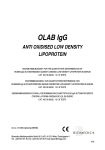
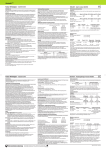


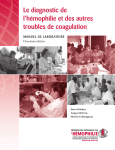

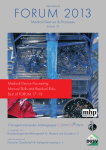


![[APTT-SiL Minus]. - Agentúra Harmony vos](http://vs1.manualzilla.com/store/data/006356908_1-375f15e67189b727c91a121fb0458e7e-150x150.png)
